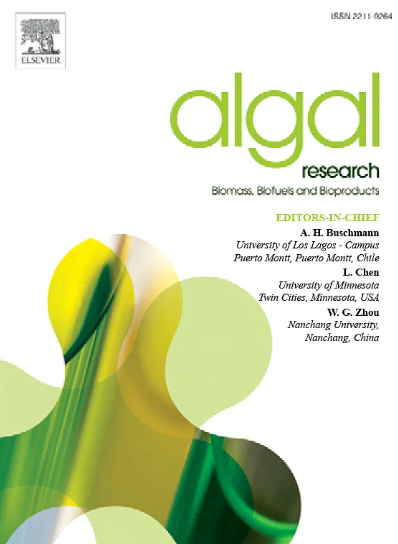Selective cyanobactericidal activity of Nocardioides convexus MS16 against Microcystis aeruginosa, mediated by direct attack
IF 4.6
2区 生物学
Q1 BIOTECHNOLOGY & APPLIED MICROBIOLOGY
Algal Research-Biomass Biofuels and Bioproducts
Pub Date : 2025-06-20
DOI:10.1016/j.algal.2025.104165
引用次数: 0
Abstract
A cyanobactericidal bacterium, Nocardioides convexus MS16, was isolated from the co-culture solution of Microcystis aeruginosa and Myriophyllum spicatum (Eurasian watermilfoil), an aquatic plant known for its inhibitory effects on the growth of M. aeruginosa. The present study investigated the cyanobactericidal activity of N. convexus MS16 against M. aeruginosa KW, evaluating its potential as a biocontrol agent for managing Microcystis blooms. To determine the algicidal mode of action, treatments using the bacterial culture, washed cells (direct attack), and cell-free filtrate (indirect allelopathy) were compared. The MS16 strain exhibited a weak allelochemical impact but a strong direct physical attack, demonstrating algicidal activity of 84 % against M. aeruginosa KW within a day and 98 % within two days, using washed cells. The scanning electron microscope images showed that the cells of M. aeruginosa KW were damaged by cell surface-attached N. convexus MS16. Furthermore, N. convexus MS16 exhibited a selective inhibition of M. aeruginosa, compared to other cyanobacteria and green algae. The gene expression levels of ftsH, rbcL, mcyA, SOD, GSH, and recA in M. aeruginosa KW significantly decreased after treatment with N. convexus MS16 culture, indicating that M. aeruginosa had lost the ability to grow and survive. These findings highlight the potential of N. convexus MS16 to enhance the development of eco-friendly methods to mitigate harmful cyanobacterial blooms.

凸Nocardioides conv凹凸Nocardioides MS16对铜绿微囊藻的选择性杀蓝活性研究
从铜绿微囊藻(Microcystis aeruginosa)和狐尾Myriophyllum spicatum (Eurasian watermilfoil)共培养液中分离出一株杀蓝细菌Nocardioides convexus MS16。本研究研究了凸凹N. MS16对铜绿假单胞菌(M. aeruginosa KW)的杀蓝活性,评价了其作为控制微囊藻华的生物防治剂的潜力。为了确定杀藻方式,比较了使用细菌培养,洗涤细胞(直接攻击)和无细胞滤液(间接化感作用)的处理。MS16菌株对M. aeruginosa KW具有较弱的化感作用,但具有较强的直接物理作用,在洗涤细胞中,对M. aeruginosa KW在一天内的杀藻活性为84%,在两天内的杀藻活性为98%。扫描电镜图像显示,铜绿假单胞菌(M. aeruginosa KW)细胞被细胞表面附着的凸凹假单胞菌MS16破坏。此外,与其他蓝藻和绿藻相比,N. convexus MS16对M. aeruginosa表现出选择性抑制。经凸凸N. MS16培养处理后,M. aeruginosa KW中ftsH、rbcL、mcyA、SOD、GSH和recA基因表达水平显著降低,表明M. aeruginosa丧失了生长和存活的能力。这些发现突出了凸凹N. MS16的潜力,以加强开发生态友好的方法,以减轻有害的蓝藻华。
本文章由计算机程序翻译,如有差异,请以英文原文为准。
求助全文
约1分钟内获得全文
求助全文
来源期刊

Algal Research-Biomass Biofuels and Bioproducts
BIOTECHNOLOGY & APPLIED MICROBIOLOGY-
CiteScore
9.40
自引率
7.80%
发文量
332
期刊介绍:
Algal Research is an international phycology journal covering all areas of emerging technologies in algae biology, biomass production, cultivation, harvesting, extraction, bioproducts, biorefinery, engineering, and econometrics. Algae is defined to include cyanobacteria, microalgae, and protists and symbionts of interest in biotechnology. The journal publishes original research and reviews for the following scope: algal biology, including but not exclusive to: phylogeny, biodiversity, molecular traits, metabolic regulation, and genetic engineering, algal cultivation, e.g. phototrophic systems, heterotrophic systems, and mixotrophic systems, algal harvesting and extraction systems, biotechnology to convert algal biomass and components into biofuels and bioproducts, e.g., nutraceuticals, pharmaceuticals, animal feed, plastics, etc. algal products and their economic assessment
 求助内容:
求助内容: 应助结果提醒方式:
应助结果提醒方式:


